Madonna and Child with Angels and Saints was an oil on panel triptych by Filippo Lippi, executed in 1440. [1]
Its central panel has been in the Metropolitan Museum of Art in New York since 1949 and its side panels of Saints Augustine and Ambrose and Saints Gregory and Jerome are both in the Accademia Albertina in Turin. [2] The work was probably split up around the end of the 18th Century. When archbishop Vincenzo Maria Mossi gave his collection to the Accademia in 1828 he only presented the two side panels. The work was reunited at the "Exposition de l'art italien de Cimabue à Tiepolo" in Paris in 1935 and in the "Filippo Lippi. Un trittico ricongiunto" exhibition at the Accademia in October 2004.

Filippino Lippi was an Italian painter working in Florence, Italy during the later years of the Early Renaissance and first few years of the High Renaissance.
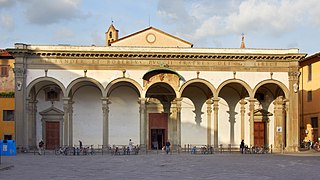
The Basilica della Santissima Annunziata is a Renaissance-style, Catholic minor basilica in Florence, region of Tuscany, Italy. This is considered the mother church of the Servite Order. It is located at the northeastern side of the Piazza Santissima Annunziata near the city center.

Filippo Lippi, also known as Lippo Lippi, was an Italian painter of the Quattrocento and a Carmelite priest. He was an early Renaissance master of a painting workshop, who taught many painters. Sandro Botticelli and Francesco di Pesello were among his most distinguished pupils. His son, Filippino Lippi, also studied under him and assisted in some late works.
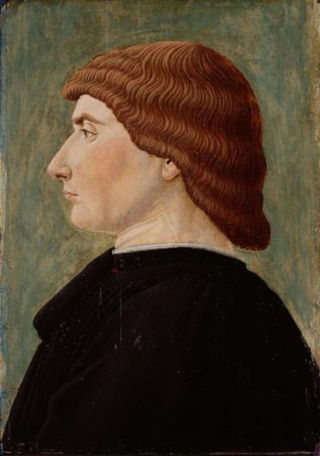
Fra Carnevale OP was an Italian painter of the Quattrocento, active mainly in Urbino. Widely regarded as one of the most enigmatic artists, there are only nine works that can be definitively attributed to Carnevale known of today. Most of these have even been contested as authentic to Carnevale at various points in history.

The Trivulzio Madonna is a painting by the Italian Renaissance painter Andrea Mantegna, executed in 1497. It is housed in the Sforza Castle Pinacoteca of the Castello Sforzesco, Milan.

The Coronation of the Virgin or Coronation of Mary is a subject in Christian art, especially popular in Italy in the 13th to 15th centuries, but continuing in popularity until the 18th century and beyond. Christ, sometimes accompanied by God the Father and the Holy Spirit in the form of a dove, places a crown on the head of Mary as Queen of Heaven. In early versions the setting is a Heaven imagined as an earthly court, staffed by saints and angels; in later versions Heaven is more often seen as in the sky, with the figures seated on clouds. The subject is also notable as one where the whole Christian Trinity is often shown together, sometimes in unusual ways. Crowned Virgins are also seen in Eastern Orthodox Christian icons, specifically in the Russian Orthodox church after the 18th century. Mary is sometimes shown, in both Eastern and Western Christian art, being crowned by one or two angels, but this is considered a different subject.
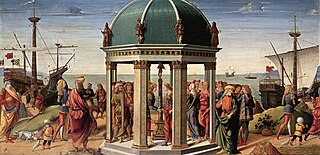
Biagio d’Antonio Tucci was an Italian Renaissance painter active in Florence, Faenza and Rome.

Francesco Pesellino, also known as Francesco di Stefano, was an Italian Renaissance painter active in Florence. His father was the painter Stefano di Francesco, and his maternal grandfather was the painter Giuliano Pesello (1367–1446), from whose name the diminutive nickname "Pesellino" arose. After the death of his father in 1427, the young Pesellino went to live with his grandfather whose pupil he became. Pesellino remained in his grandfather's studio until the latter's death, when he began to form working partnerships with other artists, such as Zanobi Strozzi and Fra Filippo Lippi. He married in 1442, and probably joined the Florentine painters' guild in 1447. In the following years he made for reputation with small, highly-finished works for domestic interiors, including religious panels for private devotional use and secular subjects for pieces of furniture.
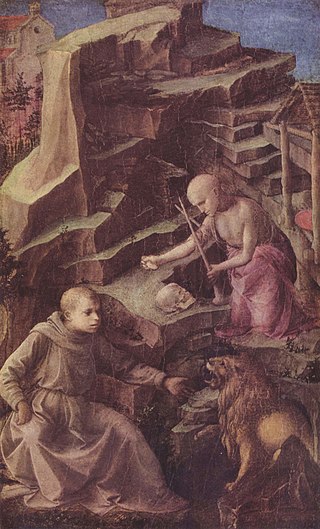
The St Jerome in Penance is a painting by the Italian Renaissance painter Filippo Lippi, dating to c. 1439. It is housed in the Lindenau-Museum of Altenburg, Germany. The work could be identified with the St. Jerome Penitent of which Lippi asked payment in a letter issued to Piero de' Medici in 1439.

The Coronation of the Virgin is a painting of the Coronation of the Virgin by the Italian Renaissance master Filippo Lippi, in the Uffizi, Florence.

The Barbadori Altarpiece is a painting by Filippo Lippi, dated to 1438 and housed in the Louvre Museum of Paris.

The Funeral of St. Jerome is a painting by the Italian Renaissance painter Filippo Lippi of Saint Jerome's funeral. It is housed in the Museo dell'Opera del Duomo next to the Cathedral of Prato, central Italy.

Seven Saints is a tempera on panel painting by the Italian Renaissance master Filippo Lippi, dating to c. 1449–1459, in the collection of the National Gallery, London. It is a pendant to Lippi's Annunciation, also in the National Gallery. The lunettes were commissioned as part of the decoration of the Palazzo Medici in Florence, where they were likely placed above a door or a bed.

The Annunciation is a tempera on panel painting by the Italian Renaissance master Filippo Lippi, dating to c. 1449–1459, in the collection of the National Gallery, London. It is a pendant to Lippi's Seven Saints, also in the National Gallery. The lunettes were commissioned as part of the decoration of the Palazzo Medici in Florence, where they were likely placed above a door or a bed.

The Marsuppini Coronation is a painting of the Coronation of the Virgin by the Italian Renaissance painter Filippo Lippi, dating to after 1444. It is in the Pinacoteca Vaticana, Rome.
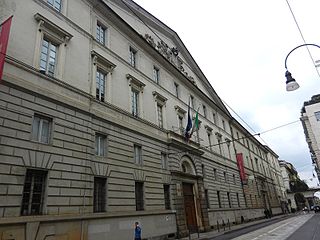
The Accademia Albertina di Belle Arti is an institution of higher education in Turin, Italy

The Stories of St. Stephen and St. John the Baptist is a fresco cycle by the Italian Renaissance painter Filippo Lippi and his assistants, executed between 1452 and 1465. It is located in the Great Chapel of the Cathedral of Prato, Italy.
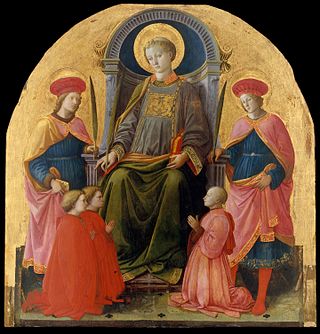
The Alessandri Altarpiece is a tempera on panel painting by Filippo Lippi, also known as Saint Lawrence Enthroned Between Saints Cosmas and Damian and Donors and Saint Lawrence Enthroned with Saints and Donors. It is now in the Metropolitan Museum of Art in New York.

The Novitiate Altarpiece or Madonna and Child with Saints is a c.1440-1445 tempera on panel painting by Filippo Lippi, now in the Uffizi in Florence. A sacra conversazione, it originally had a predella painted by Pesellino centred on a Nativity. The main panel shows Cosmas and Damian either side of the Madonna and Child, whilst Francis of Assisi is shown at far left and Anthony of Padua at far right. On an architectural frieze above the figures are the Medici's heraldic balls.
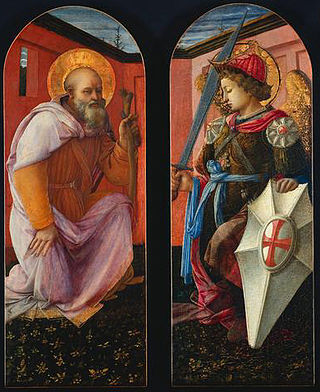
St Anthony Abbot and Michael the Archangel are two tempera on panel works by Filippo Lippi, originally side-panels to a now lost central panel of the Madonna and Child. Produced between around 1445 and 1450, they are both now in the Cleveland Museum of Art, which also houses a later copy of the central panel by Lippi's workshop.